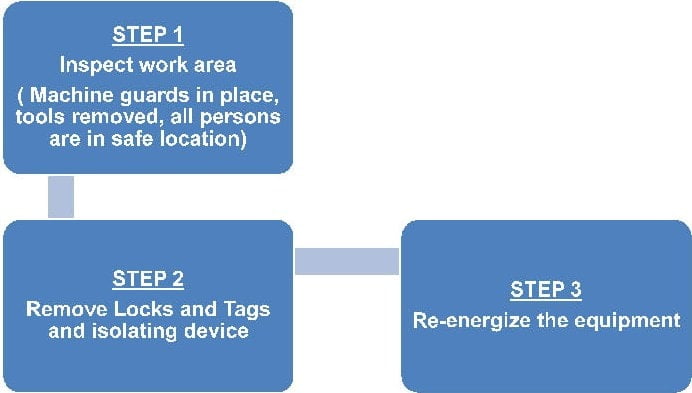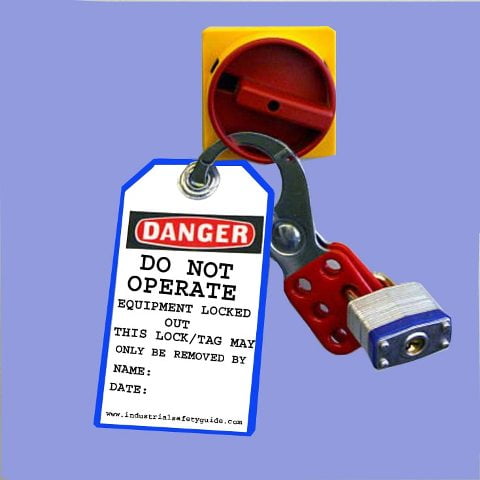Lockout Tagout is a specific set of procedures to safeguard employees from unexpected energization or startup of machinery and equipment or the release of hazardous energy during service or maintenance activities. They are used to keep employees safe from equipment or machinery or hazardous energy that could injure or kill them if not managed correctly. A huge number of today’s industrial accidents are caused by the uncontrolled release of energy or by the unexpected start-up of machines or equipment. Lockout Tagout is also commonly known as LOTO.
Table of Contents
Lock out:
The placement of a lock on an energy-isolating device ensuring that the energy-isolating device and the equipment being controlled cannot be operated until the lock is removed. All lockout devices must be –
- Durable and capable of withstanding the environment they are to be used in.
- Standardized by color, shape, or size and Substantial enough to prevent removal without the use of excessive force or unusual technique.
- Be singularly identified, must be the only devise for controlling energy and must not be used for other purposes.
- Must indicate the identity of the employee applying the device.
Tag out:
The placement of a tag on an energy-isolating device indicates that the energy-isolating device and the equipment being controlled may not be operated until the tag is removed. All Tagout devices must –
- Include a legend such as Do Not Start, Do Not Open, Do Not Close, Do Not Energize, etc.
- Be durable and capable of withstanding the harsh environment conditions.
- Have print and format standardized by color, shape, or size &
- Be substantially strong enough to prevent inadvertent or accidental removal.
Locked label or notice of ‘Lockout’ indicates that this equipment or machine is faulty, under repair or maintenance, and is locked for the purpose of not using it till this lock or notice exists. Tag-out means to tie a tag on the equipment or machine to indicate that it is under repair or maintenance and not to be touched or used. Tag out is most essential when the lockout is not possible. It can be used in addition to lockout for further precaution.
Lockout and Tag out procedure is also required to prevent an accident from unexpected starting or operation of any switch, starter, motor equipment, etc. When some repair or maintenance work is to be started on an electric line or some vessel, pipeline, etc, source of supply of power, energy, flow, etc needs to be isolated and for this purpose, such switch, lever, valve, control knob, etc should be kept in locked-off position by positive locking and tagging indicating instruction not to open the lock or operate that switch, valve, etc.
When more than one department wants lockout of the same switch, valve, equipment, etc, each of them should apply their own lock and tagging. In such multiple locking, each key should be different and no master keying should be available. In case of difficulty, the lock may be broken down but no duplicate key should be available.
Lockout tagout procedures
- Survey and identify energy sources and their associated hazards, obtain equipment, and review the equipment-specific Lockout Tagout procedures if needed. Any questions should be directed to the immediate supervisor.
- Notify all affected employees that a Lockout Tagout(LOTO) system is going to be utilized and the reason .why the equipment is being locked out.
- If the equipment is in the “on” or “powered” position, shut it down by the normal stopping procedure.
- Isolate the equipment from its energy source.
- Lockout and Tagout the energy isolating sources with assigned locks and tags. This usually requires locking out the electrical disconnect. Use valve covers, plug locks, etc. on equipment that cannot be directly locked out. For group lockout always use hasps. (A Tagout system alone is not acceptable at any time unless the equipment is not capable of being locked out. The tag must be placed at the same location that the lockout device would have been attached, and additional measures must be taken to ensure the level of safety is equivalent to that obtained by using a lock. This includes blocking of a controlling switch, removal of an isolating circuit element, opening of an extra disconnect device, or removal of a valve handle only.)
- Disperse stored energy (springs, hydraulic systems, air, gas, water pressure, or steam).
- After ensuring that no other personnel is exposed, attempt to turn on the equipment using the push button, toggle switch, etc. to ensure that the lockout was effective. After ensuring that lockout was effective, return the equipment to the “off” position.
- Equipment is now locked out and ready to be serviced.
Lockout tagout Process Flow chart

Restoring Equipment to Use after LOTO
- After completion of servicing or maintenance is complete, check the area around the equipment to ensure that no one is exposed.
- Verify that all tools have been removed from the equipment and all guards have been reinstalled.
- Notify affected employees of the impending re-energization of the equipment.
- Remove the Lockout and Tagout devices. Removal of the Lockout and Tagout devices is limited to the authorized employee who applied the device. See abandoned lock procedure if the Lockout and Tagout devices were inadvertently left on the equipment.
- Energize the equipment.
Lockout Tagout removal process flow chart

The Purpose of Lockout Tagout
When machines or equipment are being prepared for service or maintenance, they often contain some form of hazardous energy that can cause harm to people in the area. When we talk about hazardous energy, we mean any type of energy that can be released and might harm a person. This could include the energy of the following types:
- Chemical
- Electrical
- Hydraulic
- Mechanical
- Pneumatic
- Thermal
- Other sources of energy
Without the use of proper LOTO safety procedures, the serviced equipment can unexpectedly start-up or otherwise release these forms of energy. This can lead to injuries and even death to the people working on the machine and even to others working in the area or living in the community.
Energy sources including electrical, mechanical, hydraulic, pneumatic, chemical, thermal, or other sources in machines and equipment can be hazardous to workers. During the servicing and maintenance of machines and equipment, the unexpected startup or release of stored energy can result in serious injury or death to workers.

